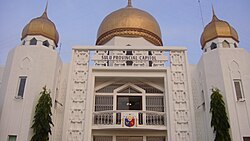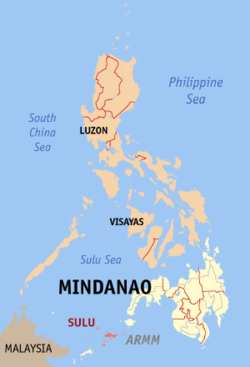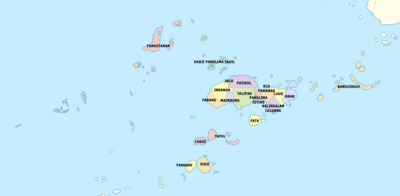Sulu
This article needs additional citations for verification. (August 2014) (Learn how and when to remove this template message)
|
Sulu
| |||
|---|---|---|---|
| Province | |||
| Province of Sulu | |||

Sulu Provincial Capitol Building in Jolo
| |||
| |||
 Location in the Philippines | |||
| Coordinates: 6°N 121°ECoordinates: 6°N 121°E | |||
| Country | Philippines | ||
| Region | Autonomous Region in Muslim Mindanao (ARMM) | ||
| Founded | March 10, 1917 | ||
| Capital | |||
| Government | |||
| • Type | Sangguniang Panlalawigan | ||
| • Sultan | Sultan Mudarasulail Kiram | ||
| • Governor | Abdusakur "totoh" Tan II (Liberal Party) | ||
| • Vice Governor | Nurunisah Abubakar - Tan (Liberal Party) | ||
| Area[1][2] | |||
| • Total | 1,600.40 km2(617.92 sq mi) | ||
| Area rank | 66th out of 81 | ||
| Highest elevation (Bud Dajo) | 620 m (2,030 ft) | ||
| Population (2015 census)[3] | |||
| • Total | 824,731 | ||
| • Rank | 33rd out of 81 | ||
| • Density | 520/km2 (1,300/sq mi) | ||
| • Density rank | 10th out of 81 | ||
| Divisions | |||
| • Independent cities | 0 | ||
| • Component cities | 0 | ||
| • Municipalities | |||
| • Barangays | 410 | ||
| • Districts | 1st and 2nd districts of Sulu | ||
| Time zone | PHT (UTC+8) | ||
| ZIP code | 7400–7416 | ||
| IDD : area code | +63 (0)68 | ||
| ISO 3166 code | PH | ||
| Spoken languages | |||
| Website | www | ||
Sulu (Tausūg: ولايا سين سوگ, Wilāya sin Sūg; Chavacano: Provincia de Sulu) is a province of the Philippines in the Sulu Archipelago and part of the Autonomous Region in Muslim Mindanao (ARMM).
Its capital is Jolo on the island of the same name. Sulu is along the southern border of the Sulu Sea and the northern boundary of the Celebes Sea.Its head of state is Sultan Mudarasulail Kiram
Contents
[hide]
History[edit]
Pre-Spanish and Spanish eras[edit]
The advent of Islam around 1138 through merchants and traders had a distinct influence on Southeast Asia. The coming of Arabs, Persians and other Muslims paved the way for the arrival of religious missionaries, traders, scholars and travelers to Sulu and Mindanao in the 12th century.
A landmark born of the social process was the founding of the Sultanate of Sulu. Year 1380 CE, Karim-ul Makhdum came to Sulu and introduced Islam to the Philippines. Year 1450 CE, a Johore-born Arab adventurer, Sayyid Abubakar Abirin came to Sulu and lived with Rajah Baguinda Ali, eventually marrying his daughter Dayang-dayang Paramisuli and eventually inheriting Rajah Baguinda's polity (which was a principality before) and turning it into a sultanate. Sayyid Abubakar eventually inherited the rule of Rajah Baguinda, established the Sultanate of Sulu and became its first Sultan. To consolidate his rule, Sayyid Abubakar united the local political units under the umbrella of the Sultanate. He brought Sulu, Zamboanga Peninsula, Palawan and Basilan under its aegis.
The navigational error that landed Ferdinand Magellan in Limasawa brought awareness of Europe to the Philippines and opened the door to Spanish colonial incursion. The Spaniards introduced Christianity and a political system of church-state dichotomy, which encountered fierce resistance in the devastating Moro wars from 1578 to 1899. The Sultanate of Sulu formally recognised Spanish sovereignty in Tawi-Tawi and Sulu in middle of 19th century, but these areas remained partially ruled by the Spanish as their sovereignty was limited to military stations and garrisons and pockets of civilian settlements, until they had to abandon the region as a consequence of their defeat in the Spanish–American War.
American and Contemporary eras[edit]
After Spain ceded the Philippines to the United States, American forces came to Jolo and ended the 23 years of Spanish military occupation (1876 to 1899). On August 20, Sultan Jamalul Kiram II and Brig. Gen. John C. Bates signed the Bates Agreement that continued the gradual emasculation of the Sultanate started by Spain (Treaty of 1878) until March 1915 when the Sultan abdicated his temporal powers in the Carpenter Agreement. The Agreement eliminated opposition to the civilian government of Gov. Clinton Solidum.
The Department of Mindanao and Sulu under Gov. Carpenter was created by Philippine Commission Act 2309 (1914) and ended on February 5, 1920 by Act of Philippine Legislature No. 2878. The Bureau of Non-Christian Tribes was organized and briefly headed by Teofisto Guingona, Sr. With the enactment by the US Congress of the Jones Law (Philippine Autonomy Law) in 1916, ultimate Philippine independence was guaranteed and the Filipinization of public administration began. Sulu, however, had an appointed American governor until 1935 and the Governor General in Manila had a say in Sulu affairs.
At any rate, the essence of local governance forged by Rajah Baguinda continued to permeate the ethos of Sulu politics despite centuries of colonial presence. History points to a local government in Sulu that antedates other similar systems in the country.
The province hosted the Daru Jambangan (Palace of Flowers) which was the royal palace of the Sultan of Sulu since historical times. The palace, located in Maimbung was made of wood, and was destroyed in 1932 by a huge storm. Today, a few arches and posts remain from the once grand palace complex. Many members of the royal family advocated for the reconstruction of the palace, and even its enlargement, however, the government of the Philippines has yet to establish a position or a fund for the matter.
Today, Sulu has a locally constituted government and is part of the ARMM.
Geography[edit]
The province covers an area of 1,600.40 square kilometres (617.92 sq mi).[2] Sulu's main island, Jolo, has an area of 868.5 square kilometres (335.3 sq mi),[4] making it the 16th largest island of the Philippine Archipelago by area.
Sulu is a part of the Sulu Archipelago, which stretches from the tip of the Zamboanga Peninsula on the north to the island of Borneo in the south. The main island and its islets are situated between the island-provinces of Basilan to the northeast, and Tawi-Tawi to the southwest. Sulu is bordered by two seas; the Sulu Sea to the north, and the Celebes Sea to its south. Sulu has over 157 islets, some of which remain unnamed.[1]
The islands are organized into four groups:[1]
- Jolo group
- Pangutaran group
- Tongkil-Banguingui (Samales) group
- Siasi-Tapul group
Administrative divisions[edit]
Sulu comprises 19 municipalities, organized into two legislative districts and further subdivided into 410 barangays.
† Provincial capital
| ||||||||||||||||||||||||||||||||||||||||||||||||||||||||||||||||||||||||||||||||||||||||||||||||||||||||||||||||||||||||||||||||||||||||||||||||||||||||||||||||||||||||||||||||||||||||||||||||||||||||||||||||||||||||||||||||||||||||||||||||||||||||||||||||||||||||||||||||||||||||||||||||||||
Demographics[edit]
| Population census of Sulu | ||
|---|---|---|
| Year | Pop. | ±% p.a. |
| 1980 | 360,588 | — |
| 1990 | 469,971 | +2.69% |
| 1995 | 536,201 | +2.50% |
| 2000 | 619,668 | +3.15% |
| 2007 | 849,670 | +4.45% |
| 2010 | 718,290 | −5.93% |
| 2015 | 824,731 | +2.67% |
| Source: National Statistics Office[3][6][8] | ||
The population of Sulu in the 2015 census was 824,731 people,[3] with a density of 520 inhabitants per square kilometre or 1,300 inhabitants per square mile.
Although consisting of a mixed community of Muslims, the Tausug dominate the Sulu Archipelago. The Tausug were among the first inhabitants of the Philippines to embrace Islam as a religion and a way of life. They are referred to as ‘people of the current’, reflective of their close ties to the sea. The Tausug language is the lingua franca of Sulu. The other local language is the indigenous Bahasa Sama which is widely used in varied tones and accents. This variety led to the development of Sinama dialects. The major ones are Sinama Sibutu (spoken mainly in the Sibutu-Sitangkai Region), Sinama Simunul (concentrated in Simunul-Manuk-Mangkaw Islands), Sinama Kapoan (spoken in the South Ubian-Tandubas and Sapa-Sapa Regions) and Sinama Banguingui (concentrated in Buan Island and spoken by Banguingui people).
The Bajau-Sama language is also spoken, as are English and Tagalog. Many locals and barter traders can speak Malay and Indonesian. Chavacano is also spoken by Christian and Muslim locals who maintain contacts and trade with the mainland Zamboanga Peninsula and Basilan, as Tawi-tawi and Sulu were partially ruled by the Spanish as their sovereignty was limited to military stations and garrisons and pockets of civilian settlements, until they had to abandon the region as a consequence of their defeat in the Spanish–American War. The rest of Muslims speak Cebuano because of the mass influx of Cebuano settlers to Mindanao, especially with the Tau Sūg since Tausug is a Visayan language.
Religion[edit]
Sulu inhabitants are predominantly Muslim, constituting about 97% of the provincial population in 2000, with a minority of Christians (2.6%).[1]
A majority of Sulu's Muslim population practice Sunni Islam of the Shafi'i tradition, as taught by Arab, Persian, Indian Muslim, Chinese Muslim and Malaccan missionaries from the 14th century onwards.
Relatively newer Islamic sects, mostly brought by returning veterans of the Afghan wars and missionaries from Pakistan's stricter Sufi traditions, referred to as the Tableegh, have been active in propagating what they believe to be a "purer" Islamic way of life and worship. A very small number who have since married into Iranian or Iraqi families have converted to Shiite Islam.
Majority of Sulu Christians are Roman Catholics,[1] they are under the jurisdiction of Roman Catholic Archdiocese of Zamboanga through its suffragan Apostolic Vicariate of Jolo. Non-Catholic Christians include Evangelicals, Jesus Miracle Crusade, Episcopalian, and Iglesia ni Cristo (INC), Mormons, Seventh-day Adventists, Jehovah's Witnesses, and a number of other Protestant denominations. Only the most recent Chinese immigrants adhere to Buddhism or Taoism, while most of the older Chinese families have acculturated and have either converted to Christianity or Islam while retaining most of their Chinese beliefs.
Economy[edit]
Sulu is predominantly agricultural with farming and fishing as its main livelihood activities. Its fertile soil and ideal climate can grow a variety of crops such as abaca, coconuts, Sulu coffee,[9] oranges, and lanzones as well as exotic fruits seldom found elsewhere in the country such as durian and mangosteen.
Fishing is the most important industry since the Sulu Sea is one of the richest fishing grounds in the country. The province also have an extensive pearl industry. Pearls are extensively gathered and a pearl farm is established at Marungas Island. The backs of sea turtles are made into beautiful trays and combs. During breaks from fishing, the people build boats and weave mats. Other industries include coffee processing and fruit preservation.
The handicrafts of Sulu have both Islamic and Malay influences. Skilled artisans make boats, bladed weapons, bronze and brassware, pis cloth, embroidered textiles, shellcraft, traditional house carvings, and carved wooden grave markers.
The province used to be one of the most prosperous in southern Philippines, however, due to conflicts, terrorism, and the establishment of jihadists groups such as the Abu Sayyaf, the province's economy has suffered badly and has been reduced to its current state.
See also[edit]
- Bangsamoro
- Moro people
- Islam in the Philippines
- Moro Islamic Liberation Front
- Sultanate of Sulu
- Moro National Liberation Front
References[edit]
- ^ a b c d e f "Brief Profile". Province of Sulu, Philippines. Archived from the original on 26 February 2011. Retrieved 18 April 2016.
Various government agencies report varying land areas for Sulu. According to the National Mapping and Resources Information Authority, Sulu has a total land area of 160,040 hectares. On the other hand, based on the National Statistics Office (NSO) 2000 Demographic and Socio-Economic profile, the province has a land area of 1,754.6.
- ^ a b Province of Sulu: Brief Profile (There seems to be major discrepancies among authoritative sources: 343,699 ha (NSCB 2007), 175,460 ha (NSCB 2000), 167,377 ha (NAMRIA))
- ^ a b c d Census of Population (2015). Highlights of the Philippine Population 2015 Census of Population. PSA. Retrieved 20 June 2016.
- ^ "Islands by Land Area". Island Directory Tables. United Nations Environment Programme. Retrieved 25 August 2014.
- ^ a b "Province: Sulu". PSGC Interactive. Quezon City, Philippines: Philippine Statistics Authority. Retrieved 8 January 2016.
- ^ a b Census of Population and Housing (2010). Population and Annual Growth Rates for The Philippines and Its Regions, Provinces, and Highly Urbanized Cities (PDF). NSO. Retrieved 29 June 2016.
- ^ "PSGC Interactive; List of Provinces". Philippine Statistics Authority. Retrieved 18 April 2016.
- ^ Census of Population and Housing (2010). "ARMM - Autonomous Region in Muslim Mindanao". Total Population by Province, City, Municipality and Barangay. NSO. Retrieved 29 June 2016.
- ^ http://cnnphilippines.com/life/leisure/food/2016/11/11/sulu-coffee.html
External links[edit]
 Media related to Sulu at Wikimedia Commons
Media related to Sulu at Wikimedia Commons Geographic data related to Sulu at OpenStreetMap
Geographic data related to Sulu at OpenStreetMap- Philippine Standard Geographic Code
- Local Governance Performance Management System











Komentar
Posting Komentar